Synthesis and characterization of coordination and organic compounds with photovoltaic applications
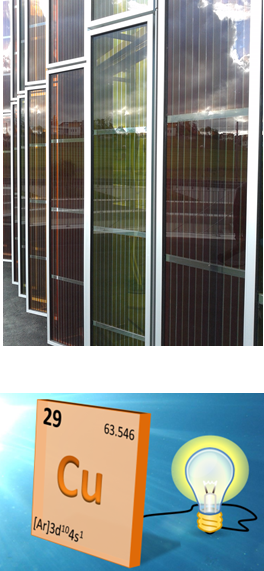
Dye-Sensitized Solar Cells
In the early 1990s Dye-Sensitized Solar Cells (DSSC) have emerged as a realistic solution for harnessing the energy of the Sun and converting it into electricity since then an impressive amount of work has been carried out in order to improve their photovoltaic efficiency. Today the future of DSSC is strictly connected to the research and development of cheaper materials. In this context, copper is both a valid alternative to the ruthenium in the preparation of photosensitizers and a material able to replace the common triiodide/iodide redox couple in the development of less corrosive iodine-free electrolytes.
Recently we reported for the first time an environmentally friendly “full copper” DSSCs. Starting from these good results our aim is to improve the solar light harvesting of the Cu-dyes, with well-designed functional groups, and to increase the Voc, by looking for an optimal concentration of the Cu-based electrolytes in the presence of additives such as tert-butylpyridine, as commonly employed with conventional I–/I3– electrolyte.
[see for example: Coordination Chemistry Reviews 2016, 322, 69-93; ACS Appl. Energy Mater., 2018, 1, 751-756]

Luminescent solar concentrators
In the field of solar energy, the use of polymer-based luminescent solar concentrators (LSCs) represents a promising strategy to improve the diffuse light response of conventional photovoltaic (PV) devices and to concentrate light without the need for expensive tracking equipment. In addition, thanks to their light weight combined with the possibility to modulate their shape and color, LSCs offer the potential to integrate PV technology into built environments and into urban applications However, to prove the real commercial viability of this technology, a sufficient device lifetime is required, so as to guarantee stable response during operation. In this respect, one critical aspect affecting the lifetime of LSC devices is represented by the degradation of the luminescent species.
Consequently, the quest for alternative matrices which are intrinsically stable under continuous light exposure still represents an active and ongoing research area in the field of LSC devices. In this context we develop (for example modified perylene-based derivatives) dye to be used for the fabrication of thin-film LSC devices.
[see for example: Journal Materials Chemistry A, 2017, 5, 9067-9075]

Down-shifting materials
The presence of organic material in a polymer cell is a disadvantage because its exposition to the UV irradiation causes photooxidation and molecules splitting, which reduces cell lifetime due to prolonged exposition to solar light. These devices can’t be used outdoor because of this problem; to overcome this, a new idea was born in this context: add to the cell a protective layer of a luminescent down-shifting material (LDS).
Consequently, the quest for alternative matrices which are intrinsically stable under continuous light exposure still represents an active and ongoing research area in the field of LSC devices. In this context we develop (for example modified perylene-based derivatives) dye to be used for the fabrication of thin-film LSC devices.
The key point of this new system is the presence of a luminophore (LM) which absorbs UV-photons (λ < 400 nm) of solar spectrum and re-emits them at longer wavelengths (luminescence) where the PV material exhibits optimal spectral response. In this context, we prepare organic and organometallic dyes with luminescent downshifting properties which can be tested in collaboration with Dr Gianmarco Griffini from department of Chemistry, Materials and Chemical Engineering “Giulio Natta”, Politecnico di Milano.
[see for example: Advanced Electronic Materials 2016, 1600288; Adv. Energy Mater. 2015, 5, 1401312 ]
Synthesis and photophysical characterization of organic and coordination compounds with luminescent properties
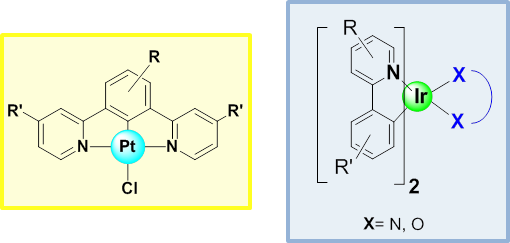
Cyclometallated Platinum(II) and Ir(III)compounds are among the brightest organometallic emitters. In our laboratories we have a well recognized expertise in the sintesis of cyclometallated Ir(IIII) complexes and to develop Pt(II) complexes characterized by strong ligand field cyclometallated terdentate ligands (N^C^N 1,3-di(2-pyridyl)benzene (dpyb)), able to guarantee a high luminescent efficiency and a high stability.
Pt(II) and Ir(IIII) complexes are very versatile compounds , they are used for example as emissive layers in OLED, as luminescent species for bioimaging, as photosensitizers in PDT and as push-pull system for NLO.
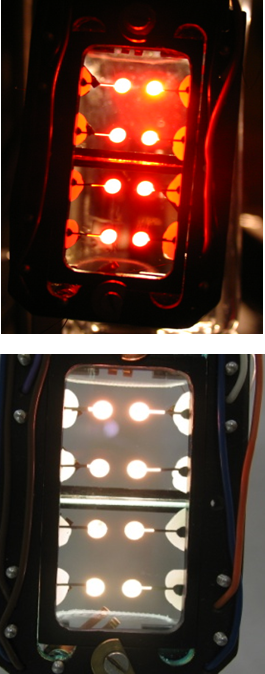
Organic Light Emitting Diodes
Organic Light Emitting Devices industry is a key sector for the actual economy, in fact OLEDs are always more present in smartphones, televisions and also solid state lighting. In the past decade, substantial investigations were carried out to develop novel materials for OLEDs, in particular, to increase the device efficiency. In this respect, luminescent materials and excitation mechanisms play a crucial role. A breakthrough was reached by applying coordination compounds based on heavy metals (Ir, Pt) because they are able to harness both singlet excitons and the formally spin-forbidden triplet excitons due to strong spin-orbit coupling interactions that can weaken the spin-forbiddenness of the electronic transitions between T1 and S0. Remarkably, the emission color of OLEDs based on these complexes can be easily tuned changing the substituents on the terdentate ligand.
[see for example: Journal of Materials Chemistry C, 2014, 2, 1791-1800;Journal of Materials Chemistry, 2012, 22, 10650-10655; Chemical Communications, 2012, 48, 3182-3184]
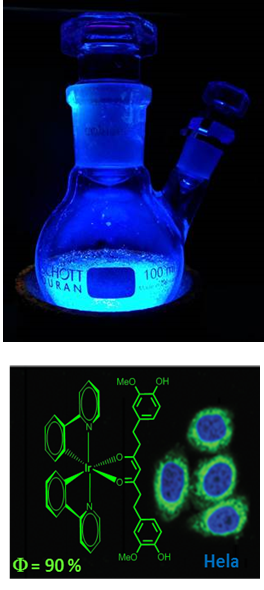
Bioimaging and Photodynamic Therapy
In recent years luminescent metal complexes are becoming particularly appealing for bio-imaging and therapy. An important aspect is to get a deep understanding of the structure-cellular compartmentalization relationship in order to allow the best chemical design for a specific targeting. It appeared that transition metal complexes can be efficient therapeutic agents for various human diseases; interestingly their steric and electronic properties can be fine-tuned changing the ancillary ligands and in some cases they can undergo ligand exchange reactions with specific biomolecules.In the last few years photodynamic therapy (PDT) is becoming of increasing interest for the treatment of several types of tumor, because it is not invasive. This therapy requires the presence of a photosensitizer, light and tissue oxygen; coordination complexes seem very promising for this application.
Our aim is to design, synthetize and characterize novel luminescent cyclometallated platinum (II) and Ir(III) complexes with potential anticancer activity related to their ability to form 1O2. The potential anticancer systems is easily localized in the tissues thanks to their high luminescence
[see for example: Chemistry A European Journal, 2019; Dalton Transactions, 2015, 44, 8478-8487
Synthesis and characterization of organic and coordination compounds with non linear optical (NLO) properties
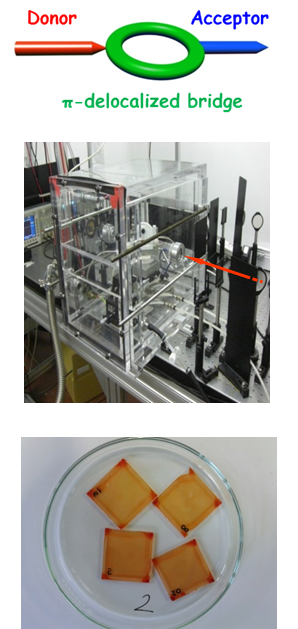
Compounds with second-order nonlinear optical (NLO) properties are of great interest as molecular building block materials for electro-optical devices. Early it was seen that molecules formed by donor (D) and acceptor (A) groups linked with an unsaturated bridge having polarizable π-electrons are particularly NLO-efficient. Compared to organic compounds, metal complexes are fascinating because they can offer further flexibility due to the presence of NLO-active CT transitions between the metal and the ligands, usually at relatively low energy and of high intensity, tunable by virtue of the nature, oxidation state and coordination sphere of the metal center. Our studies on many classes of metallic complexes (platinum, Iridum, ruthenium, Zinc derivatives) allowed to understand how the molecular design of a second order nonlinear chromophore can be intentionally achieved in order to tune, switch and optimize (by value and stability) the NLO-properties. The most promising NLO-phores are then processed to obtain composite materials (thin films in polymeric matrix) having a temporally-stable second harmonic generation (SHG) supramolecular systems. Together with advanced synthesis and processing, experimental activity will involve multitechnique characterization, including specific investigation of the materials performance by EFISH, i.e. Electric Field Induced Second Harmonic generation.
[see for example: Journal of the American Chemical Society, 2014, 136, 5367–5375]
Research Topics:
Our group, in conclusion, has maturated internationally recognized skills on the following topics: (a) Synthesis and characterization of organic and organometallic compounds for applications in medicine, non-linear optics (NLO) or solar cells. (b) Synthesis and characterization of organic ligands and their related coordination compounds for applications as photosensitizers in DSSC (c) Synthesis and characterization of coordination compounds with NLO or photoemissive and electroluminescent properties for application in electroluminescent devices (OLED and OLEC). We are fully equipped to perform the described above research activities.
